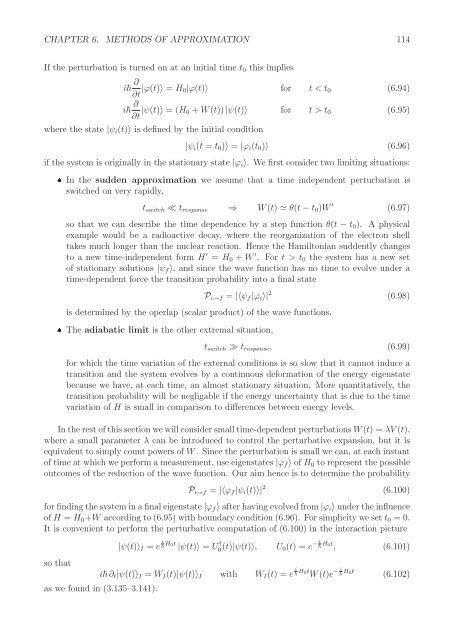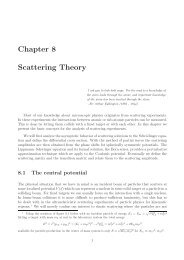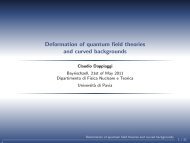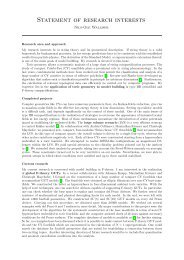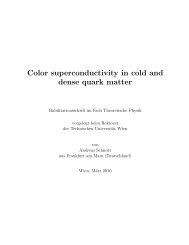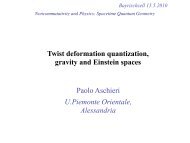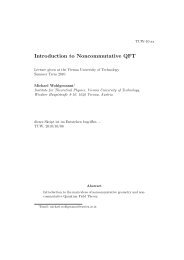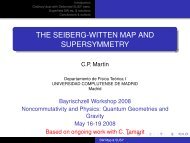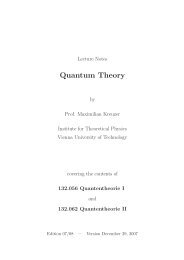Chapter 6 Methods of Approximation - Particle Physics Group
Chapter 6 Methods of Approximation - Particle Physics Group
Chapter 6 Methods of Approximation - Particle Physics Group
You also want an ePaper? Increase the reach of your titles
YUMPU automatically turns print PDFs into web optimized ePapers that Google loves.
CHAPTER 6. METHODS OF APPROXIMATION 114If the perturbation is turned on at an initial time t 0 this impliesi ∂ ∂t |ϕ(t)〉 = H 0|ϕ(t)〉 for t < t 0 (6.94)i ∂ ∂t |ψ(t)〉 = (H 0 + W(t)) |ψ(t)〉 for t > t 0 (6.95)where the state |ψ i (t)〉 is defined by the initial condition|ψ i (t = t 0 )〉 = |ϕ i (t 0 )〉 (6.96)if the system is originally in the stationary state |ϕ i 〉. We first consider two limiting situations: In the sudden approximation we assume that a time independent perturbation isswitched on very rapidly,t switch ≪ t response ⇒ W(t) ≃ θ(t − t 0 )W ′ (6.97)so that we can describe the time dependence by a step function θ(t − t 0 ). A physicalexample would be a radioactive decay, where the reorganization <strong>of</strong> the electron shelltakes much longer than the nuclear reaction. Hence the Hamiltonian suddently changesto a new time-independent form H ′ = H 0 + W ′ . For t > t 0 the system has a new set<strong>of</strong> stationary solutions |ψ f 〉, and since the wave function has no time to evolve under atime-dependent force the transition probability into a final stateP i→f = |〈ψ f |ϕ i 〉| 2 (6.98)is determined by the operlap (scalar product) <strong>of</strong> the wave functions. The adiabatic limit is the other extremal situation,t switch ≫ t response , (6.99)for which the time variation <strong>of</strong> the external conditions is so slow that it cannot induce atransition and the system evolves by a continuous deformation <strong>of</strong> the energy eigenstatebecause we have, at each time, an almost stationary situation. More quantitatively, thetransition probability will be negligable if the energy uncertainty that is due to the timevariation <strong>of</strong> H is small in comparison to differences between energy levels.In the rest <strong>of</strong> this section we will consider small time-dependent perturbations W(t) = λV (t),where a small parameter λ can be introduced to control the perturbative expansion, but it isequivalent to simply count powers <strong>of</strong> W. Since the perturbation is small we can, at each instant<strong>of</strong> time at which we perform a measurement, use eigenstates |ϕ f 〉 <strong>of</strong> H 0 to represent the possibleoutcomes <strong>of</strong> the reduction <strong>of</strong> the wave function. Our aim hence is to determine the probabilityP i→f = |〈ϕ f |ψ i (t)〉| 2 (6.100)for finding the system in a final eigenstate |ϕ f 〉 after having evolved from |ϕ i 〉 under the influence<strong>of</strong> H = H 0 +W according to (6.95) with boundary condition (6.96). For simplicity we set t 0 = 0.It is convenient to perform the perturbative computation <strong>of</strong> (6.100) in the interaction picture|ψ(t)〉 I = e i H 0t |ψ(t)〉 = U † 0(t)|ψ(t)〉, U 0 (t) = e − i H 0t , (6.101)so thati ∂ t |ψ(t)〉 I = W I (t)|ψ(t)〉 I with W I (t) = e i H 0t W(t)e − i H 0tas we found in (3.135–3.141).(6.102)


